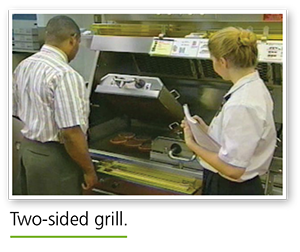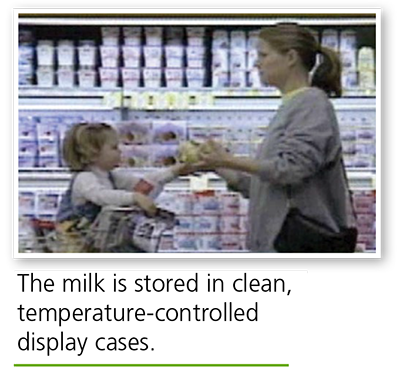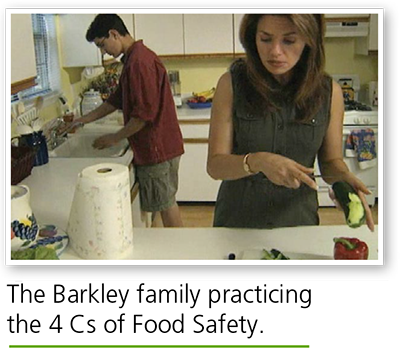Supermarket Smarts
In this activity, students will develop an awareness of the importance of food safety in retail food establishments. They will be challenged to design and manage their own food-safe supermarket department using the 4 Cs of Food Safety. At the end of this activity, each team will present its findings in an innovative presentation.
Background
Lesson Activities
Recommended Companion Resources
Credits
Author
Food and Drug Association (FDA) and National Science Teaching Association (NSTA)
Acknowledgements
The Science and Our Food Supply Curriculum was brought to you by the Food and Drug Administration Center for Food Safety and Applied Nutrition and the National Science Teaching Association.
- FDA Education Team Leader Food Safety Initiative: Marjorie L. Davidson
- FDA Science and Our Food Supply Project Director: Louise H. Dickerson
- FDA/NSTA Associate Executive Director and Science and Our Food Supply Program Director: Christina Gorski
- FDA/NSTA Science and Our Food Supply Program Assistant: Jill Heywood
Standards
Texas Content Area Standards
-
Principles of Agriculture, Food, and Natural Resources: 130.2.c.1
The student demonstrates professional standards/employability skills as required by business and industry. The student is expected to:
- Principles of Agriculture, Food, and Natural Resources: 130.2.c.1.B: apply competencies related to resources, information, interpersonal skills, problem solving, critical thinking, and systems of operation in agriculture, food, and natural resources.
-
Principles of Agriculture, Food, and Natural Resources: 130.2.c.4
The student explains the historical, current, and future significance of the agriculture, food, and natural resources industry. The student is expected to:
- Principles of Agriculture, Food, and Natural Resources: 130.2.c.4.B: analyze the scope of agriculture, food, and natural resources and its effect upon society.
- Principles of Agriculture, Food, and Natural Resources: 130.2.c.4.F: compare and contrast issues impacting agriculture, food, and natural resources such as biotechnology, employment, safety, environment, and animal welfare issues.
-
Principles of Agriculture, Food, and Natural Resources: 130.2.c.6
The student demonstrates appropriate personal and communication skills. The student is expected to:
- Principles of Agriculture, Food, and Natural Resources: 130.2.c.6.A: demonstrate written and oral communication skills appropriate for formal and informal situations such as prepared and extemporaneous presentations.
- Principles of Agriculture, Food, and Natural Resources: 130.2.c.6.B: demonstrate effective listening skills appropriate for formal and informal situations.
-
Principles of Agriculture, Food, and Natural Resources: 130.2.c.7
The student applies appropriate research methods to agriculture, food, and natural resources topics. The student is expected to:
- Principles of Agriculture, Food, and Natural Resources: 130.2.c.7.B: use a variety of resources for research and development.
-
Principles of Agriculture, Food, and Natural Resources: 130.2.c.13
The student describes the principles of food products and processing systems. The student is expected to:
- Principles of Agriculture, Food, and Natural Resources: 130.2.c.13.A: evaluate food products and processing systems.
- Principles of Agriculture, Food, and Natural Resources: 130.2.c.13.B: determine trends in world food production.
- Principles of Agriculture, Food, and Natural Resources: 130.2.c.13.C: discuss current issues in food production.
-
Social Studies: 8.113.20.b.31
Social studies skills. The student uses problem-solving and decision-making skills, working independently and with others. The student is expected to use problem-solving and decision-making processes to identify a problem, gather information, list and consider options, consider advantages and disadvantages, choose and implement a solution, and evaluate the effectiveness of the solution.
- Social Studies: 8.b.31: Social studies skills. The student uses problem-solving and decision-making skills, working independently and with others. The student is expected to use problem-solving and decision-making processes to identify a problem, gather information, list and consider options, consider advantages and disadvantages, choose and implement a solution, and evaluate the effectiveness of the solution.
-
ELA: 6.110.22.b.1
Developing and sustaining foundational language skills: listening, speaking, discussion, and thinking- oral language. The student develops oral language through listening, speaking, and discussion.
- ELA: 6.1.C: The student is expected to give an organized presentation with a specific stance and position, employing eye contact, speaking rate, volume, enunciation, natural gestures, and conventions of language to communicate ideas effectively.
- ELA: 6.1.D: The student is expected to participate in student-led discussions by eliciting and considering suggestions from other group members, taking notes, and identifying points of agreement and disagreement.
-
ELA: 6.110.22.b.12
Inquiry and research: listening, speaking, reading, writing, and thinking using multiple texts. The student engages in both short-term and sustained recursive inquiry processes for a variety of purposes.
- ELA: 6.12.A: The student is expected to generate student-selected and teacher-guided questions for formal and informal inquiry.
- ELA: 6.12.D: The student is expected to identify and gather relevant information from a variety of sources.
- ELA: 6.12.F: The student is expected to synthesize information from a variety of sources.
- ELA: 6.12.J: use an appropriate mode of delivery, whether written, oral, or multimodal, to present results.
-
ELA: 7.110.23.b.1
Developing and sustaining foundational language skills: listening, speaking, discussion, and thinking- oral language. The student develops oral language through listening, speaking, and discussion.
- ELA: 7.1.D: The student is expected to engage in meaningful discourse and provide and accept constructive feedback from others.
-
ELA: 7.110.23.b.12
Inquiry and research: listening, speaking, reading, writing, and thinking using multiple texts. The student engages in both short-term and sustained recursive inquiry processes for a variety of purposes.
- ELA: 7.12.A: The student is expected to generate student-selected and teacher-guided questions for formal and informal inquiry.
- ELA: 7.12.D: The student is expected to identify and gather relevant information from a variety of sources.
- ELA: 7.12.F: The student is expected to synthesize information from a variety of sources.
- ELA: 7.12.J: The student is expected to use an appropriate mode of delivery, whether written, oral, or multimodal, to present results.
-
ELA: 8.110.24.b.1
Developing and sustaining foundational language skills: listening, speaking, discussion, and thinking- oral language. The student develops oral language through listening, speaking, and discussion.
- ELA: 8.1.D: The student is expected to participate collaboratively in discussions, plant agendas with clear goals and deadlines, set time limits for speakers, take notes, and vote on key issues.
-
ELA: 8.110.24.b.12
Inquiry and research: listening, speaking, reading, writing, and thinking using multiple texts. The student engages in both short-term and sustained recursive inquiry processes for a variety of purposes.
- ELA: 8.12.A: The student is expected to generate student-selected and teacher-guided questions for formal and informal inquiry.
- ELA: 8.12.D: The student it expected to identify and gather relevant information from a variety of sources.
- ELA: 8.12.F: The student is expected to synthesize information from a variety of sources.
- ELA: 8.12.J: The student is expected to use an appropriate mode of delivery, whether written, oral, or multimodal, to present results.
-
Social Studies: 6.113.18.c.21
Social studies skills. The student communicates in written, oral, and visual forms. The student is expected to:
- Social Studies: 6.113.18.c.21.C: express ideas orally based on research and experiences
-
Social Studies: 6.113.18.c.22
Social studies skills. The student uses problem-solving and decision-making skills, working independently and with others. The student is expected to:
- Social Studies: 6.113.18.c.22.B: use problem-solving and decision-making processes to identify a problem, gather information, list and consider options, consider advantages and disadvantages, choose and implement a solution, and evaluate the effectiveness of the solution
-
Science: 6.112.26.b.3
Scientific and engineering practices. The student develops evidence-based explanations and communicates findings, conclusions, and proposed solutions. The student is expected to:
- Science: 6.112.26.b.3.B: communicate explanations and solutions individually and collaboratively in a variety of settings and formats; and
-
Social Studies: 7.113.19.c.23
Social studies skills. The student uses problem-solving and decision-making skills, working independently and with others. The student is expected to:
- Social Studies: 7.113.19.c.23.B: use problem-solving and decision-making processes to identify a problem, gather information, list and consider options, consider advantages and disadvantages, choose and implement a solution, and evaluate the effectiveness of the solution
-
Social Studies: 8.113.20.c.31
Social studies skills. The student uses problem-solving and decision-making skills, working independently and with others. The student is expected to:
- Social Studies: 8.113.20.c.31.B: use problem-solving and decision-making processes to identify a problem, gather information, list and consider options, consider advantages and disadvantages, choose and implement a solution, and evaluate the effectiveness of the solution
-
Science: 7.112.27.b.3
Scientific and engineering practices. The student develops evidence-based explanations and communicates findings, conclusions, and proposed solutions. The student is expected to:
- Science: 7.112.27.b.3.B: communicate explanations and solutions individually and collaboratively in a variety of settings and formats; and
-
Science: 8.112.28.b.3
Scientific and engineering practices. The student develops evidence-based explanations and communicates findings, conclusions, and proposed solutions. The student is expected to:
- Science: 8.112.28.b.3.B: communicate explanations and solutions individually and collaboratively in a variety of settings and formats; and
-
Technology Applications: 126.17.c.1
Computational thinking--foundations. The student explores the core concepts of computational thinking, a set of problem-solving processes that involve decomposition, pattern recognition, abstraction, and algorithms. The student is expected to:
- Technology Applications: 126.17.c.1.A: decompose real-world problems into structured parts by using visual representation
- Technology Applications: 126.17.c.1.B: analyze the patterns and sequences found in visual representations such as learning maps, concept maps, or other representations of data
- Technology Applications: 126.17.c.1.D: design a plan collaboratively using visual representation to document a problem, possible solutions, and an expected timeline for the development of a coded solution
-
Technology Applications: 126.17.c.5
Data literacy, management, and representation--collect data. The student uses advanced digital strategies to collect and represent data. The student is expected to:
- Technology Applications: 126.17.c.5.B: discuss and use advanced search strategies, including keywords, Boolean operators, and limiters
-
Technology Applications: 126.18.c.1
Computational thinking--foundations. The student explores the core concepts of computational thinking, a set of problem-solving processes that involve decomposition, pattern recognition, abstraction, and algorithms. The student is expected to:
- Technology Applications: 126.18.c.1.A: decompose real-world problems into structured parts using flowcharts
-
Technology Applications: 126.18.c.5
Data literacy, management, and representation--collect data. The student uses advanced digital strategies to collect and represent data. The student is expected to:
- Technology Applications: 126.18.c.5.B: evaluate advanced search strategies, including keywords, Boolean operators, and limiters
-
Technology Applications: 126.19.c.5
Data literacy, management, and representation--collect data. The student uses advanced digital strategies to collect and represent data. The student is expected to:
- Technology Applications: 126.19.c.5.B: apply appropriate search strategies, including keywords, Boolean operators, and limiters, to achieve a specified outcome that includes a variety of file formats


